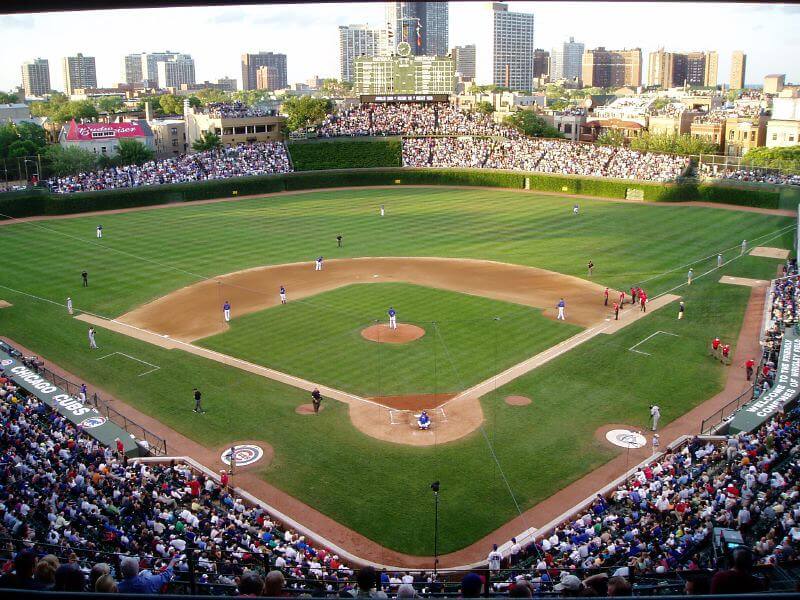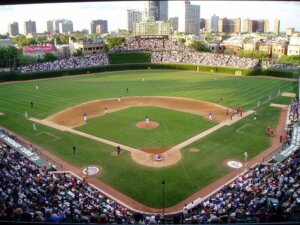
Chicago, baseball, summer — for many, these words instantly conjure up images of one iconic place: Wrigley Field. From the ivy-covered walls and the hand-turned scoreboard to the roar of the crowd, this stadium is more than just a ballpark; it’s a living, breathing piece of history. And if you’re like most Cubs fans, especially while enjoying a slice of our legendary deep dish, you’ve probably wondered, “How old is Wrigley Field anyway?” Step up to the plate, and discover the amazing story behind this beloved stadium, a true testament to baseball’s enduring appeal.
Where Did the Cubs Play Before Wrigley Field?
 To understand the history of Wrigley Field, you have to know where the Cubs called home before The Friendly Confines existed. The Cubs, originally known as the White Stockings and then the Colts and the Orphans, weren’t always playing on the North Side. In their early days, this storied franchise actually played west and then south of where Wrigley Field stands today.
To understand the history of Wrigley Field, you have to know where the Cubs called home before The Friendly Confines existed. The Cubs, originally known as the White Stockings and then the Colts and the Orphans, weren’t always playing on the North Side. In their early days, this storied franchise actually played west and then south of where Wrigley Field stands today.
In the 1870s, the team, then the White Stockings, played at Lakefront Park, located south of Randolph Street between Michigan Avenue and the Illinois Central Railroad tracks. As baseball evolved and the team grew in popularity, they needed a larger venue. This led them to West Side Park from 1885 to 1891 and to South Side Park, where they played from 1891 to 1893 before moving back to West Side Park. The final West Side Park was a wooden structure that stood from 1893 to 1915, and it was where the team won the 1907 and 1908 World Series.
As the city grew and shifted, so did the ideal location for a major league ballpark. As the 1910s rolled around, the stage was set for a new chapter in Cubs history, and a fresh ballpark in a different part of town was on the horizon. This move north would ultimately lead to the Wrigley Field you know and love today.
When Was Wrigley Field Built?
Construction on the ballpark started in 1914, making Wrigley Field a monument to baseball history. The ground hosting Wrigley Field once housed a seminary, and the ballpark was originally built for the Chicago Federals, a team in the now-defunct Federal League, a third major league. Construction was remarkably swift for the era, taking just a few months.
Wrigley Field was completed in time for the 1914 season, and the first major league game ever played at the ballpark was on April 23, 1914. It was a Federal League game, with the Federals beating the Kansas City Packers 9-1.
The ballpark’s original seating capacity was around 14,000, a far cry from the 41,649 seats it has today but still significant for its time. To put it in financial perspective, it cost $250,000 to build Wrigley Field, a substantial sum then but a tiny fraction of what modern stadiums cost.
Did Wrigley Field Ever Change Its Name?
Wrigley Field has indeed changed its name, although not in the way some might expect. When it was first built in 1914, it was known as Weeghman Park, after Charles Weeghman, the owner of the Chicago Federals.
The Cubs moved to Weeghman Park in 1916, and the first National League game at the ballpark was played on April 20, 1916, when the Cubs defeated the Cincinnati Reds 7-6 in 11 innings. This marked the beginning of Wrigley Field’s association with the Chicago Cubs, even though it wasn’t officially named Wrigley Field yet. If you’re digging into Wrigley Field’s history, remember its early years were under the name Weeghman Park.
After the Wrigley family bought the team from Weeghman, it renamed the ballpark Cubs Park in 1920. However, the stadium was renamed Wrigley Field in 1926 in honor of William Wrigley Jr., the chewing gum magnate who owned the team and the ballpark. The Wrigley family owned the Cubs and the ballpark for many decades, becoming synonymous with the team and the stadium itself.
For decades, Wrigley Field was famous for being a daytime-only ballpark. This tradition finally shifted when Wrigley Field added lights in 1988. The first night game, against the Philadelphia Phillies, was famously rained out on Aug. 8, 1988, adding a touch of classic Cubs irony to the event. The first official night game took place the next day, on Aug. 9, 1988, against the New York Mets, with the Cubs winning 6-4, marking a new era for The Friendly Confines.
By 2018, Wrigley Field celebrated its 30th year of hosting games under the lights, showing how relatively recent night games are to the stadium’s long history.
The ballpark’s management continues to upgrade the facilities, including renovating the centerfield scoreboard, adding elevators, building new home clubhouses, and several other add-ons. This ensures that the grounds can keep delivering the best baseball experience to Chicago Cubs fans and lovers of the game.
Despite these changes and additions, the enduring spirit and charm of Wrigley Field has remained remarkably consistent over the years.
Watch Cubs Games With Deep Dish Pizza From Pequod’s
Wrigley Field was built in 1914, making it the second-oldest ballpark in Major League Baseball, right after Fenway Park in Boston, which was built in 1912. From its humble beginnings as Weeghman Park to its iconic status as Wrigley Field, this stadium has witnessed over a century of baseball history, Chicago summers, and devoted fans. And what’s the best way to soak in the atmosphere of a Cubs game, whether you’re at Wrigley or cheering from your living room? With a slice of Pequod’s from our deep-dish pizza restaurant, of course. Visit us today or order frozen pizza online!
Wrigley Field by Michael Lehet is licensed with Attribution-NoDerivs 2.0 Generic